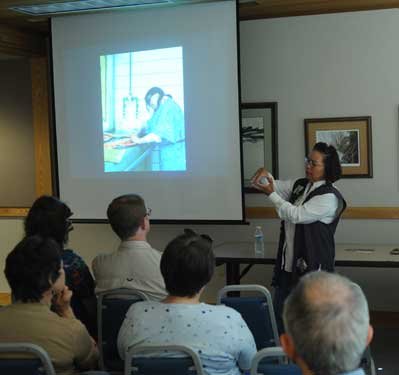|
|
|
A Partial List of Lecture Topics
at right: Pat conducting a lecture at the High Desert Museum in Bend, Oregon
|
 |
Some of the Presentations include:
Brief Chinook Nation History: The largest Native Community during pre-contact time. At the mouth of the Columbia River, they participated in international trade prior to Lewis and Clark, 1806.
Plateau Native People Heritage: The Native Tribes in the semi-arid region along the mid-Columbia River. Salmon and Trade were important parts of their lifestyle.
Columbia River Native Women: Historically, the Native Nations were matriarchal. Women could own property, partake in politics, and preserved the language and culture. Currently, women own businesses, are lawyers, and continue to preserve the traditional culture.
Columbia River Native Basketry: Twined baskets are the common basketry form. Twining technique makes them strong. They were used for storage of food items, and personal items. They were made from local indigenous plants. This artform has been passed down from generation to generation.
From Traditional to Contemporary Native Arts: Currently, Native artists are using contemporary methods to interpret and create their artwork, yet remain true to their traditions. Techniques include oil and water paints, sculptures, glass work, metal work, pen and ink, cartoon work, etc.
Columbia River People Innovators: Learn what makes the Columbia People unique. Why baskets are made with special plant fiber, why they are made the way they are, the unique dip-net fishing, the special technique of preserving their food for the following year, and more.
Art and Heritage of the Columbia River People: A summary of the downriver Native People and upriver Native People (Plateau). Learn the different ways each adapted to their wet and dry climates, what was sacred to each culture, how the clothing and basketry differed, and the importance of the River to each Nation.
Native Women’s View of Lewis and Clark: All the books written about Lewis and Clark were from a white man’s perspective. Learn about the Native People’s view of Lewis and Clark. How did the Columbia River matriarchal society see Lewis and Clark? What did they think of the smelly bearded men who ignored the sacred salmon in preference for dog meat?
|

